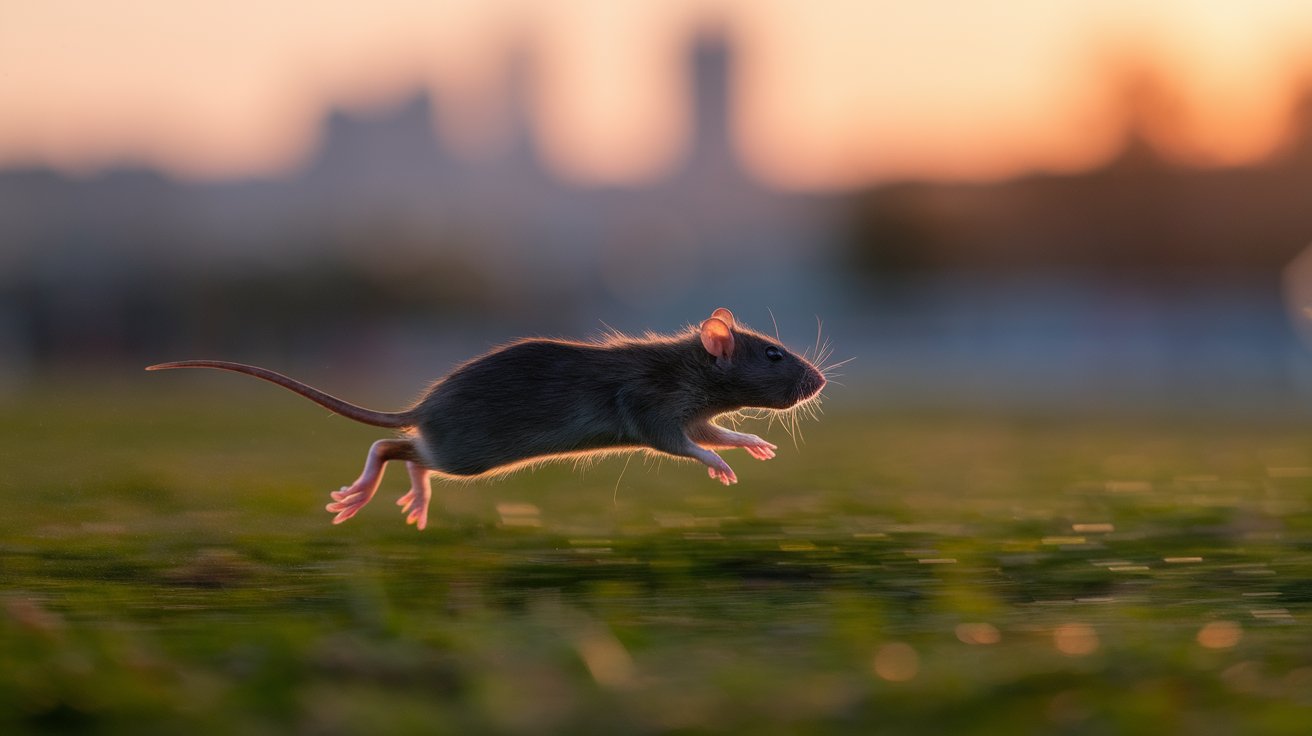Introduction
Rats, despite their small size, are remarkably fast and agile creatures. Their speed plays a crucial role in their ability to survive, whether they are evading predators or navigating through urban environments. Rats can run at speeds of up to 8 mph, using their quick reflexes and nimbleness to escape danger. Their agility allows them to dart through tight spaces and climb obstacles with ease, showcasing their adaptability in various environments. Understanding how fast a rat can run helps us appreciate the natural survival skills these creatures possess, making them highly efficient in their respective habitats.
In comparison to humans, rats may not seem fast, but when their speed is scaled to their size, they are impressively quick. While a rat can run as fast as 8 mph, human runners typically reach similar speeds, though elite athletes can go much faster. However, rats’ speed and agility are tailored to their specific needs, allowing them to maneuver quickly through challenging terrains, whether they are house rats or wild brown rats.
Key Takeaways
-
Rats can run at speeds of up to 8 mph, using their agility and speed to evade predators and navigate complex environments.
-
While humans may run at similar speeds, rats are remarkably quick for their size, showcasing impressive adaptability.
-
Rats are capable of jumping vertically as high as 36 inches, using their powerful hind legs to escape predators and access food.
-
In addition to their jumping abilities, rats are exceptional climbers, allowing them to survive in diverse environments.
-
Rats display cognitive intelligence through problem-solving, memory retention, and social learning, making them adaptable in challenging environments.
-
Wild rats typically have shorter lifespans of one to two years due to predators and disease, while domesticated rats live longer, benefiting from human care.
Rat vs. Human Speed How Fast Can a Rat Run
When comparing rats and humans in terms of speed, it’s intriguing to consider how each species excels in its environment. The speed of rats, despite their small size, is driven by their remarkable agility and quickness, which are crucial for their survival. Humans, particularly professional athletes, can achieve impressive speeds, but when you factor in the size and context of each runner, the comparison becomes even more fascinating. While rats are small, and may not seem like the fastest creatures, their ability to sprint and dart around becomes quite impressive when scaled to their body size. For anyone seeking a deeper understanding of rats, their natural speed plays a huge role in how they thrive in various environments. It’s also important to note that higher speeds allow rat species to escape predators quickly.
Rat Running Speed
Rats can reach speeds up to 8 mph, which is essential for their survival as they use this speed to escape predators, forage for food, and navigate various environments quickly. Given their small size, the speed at which rats move is particularly impressive, allowing them to swiftly maneuver through tight spaces and avoid danger. Whether it’s a black rat or a Norway rat, these rodents rely on their quickness to adapt and survive in different settings. In comparison, human can run at similar speeds, but rats are relatively more agile in short bursts, making them more adept in evasion. The ability of fast rats to run effectively aids in their survival across a variety of environments, from urban areas to wild habitats.
Human Running Speed Comparison
Humans, especially athletes, can run at speeds of around 8 miles per hour to 12 miles per hour. However, elite sprinters can reach 45 mph in short bursts. Although fast rats can run at similar speeds on paper, the comparison reveals that rats are generally much faster when considering their size. While humans excel in endurance and long-distance speed, rats employ quick bursts of agility, often surpassing humans in short-distance movement. This difference highlights how speed is adapted to the specific needs and environments of each species. Faster than rats over long distances, humans focus on endurance, but rats dominate in short, fast movements.
Rat Jumping Abilities
Rats are known for their impressive agility, and their jumping abilities are no exception. Their remarkable skills allow them to leap both vertically and horizontally, helping them evade predators and navigate new environments. Whether it’s a mouse, black rat, or Norway rat, these rodents rely on strong hind legs to perform leaps that seem surprising for their size. An essential part of understanding rats is recognizing how high can a rat jump, which highlights their adaptability in both urban and natural settings. When you see a rat make such leaps, it’s clear that they are highly capable survivors. Their jumping abilities, combined with climbing skills, not only aid in pest control by helping them escape danger but also ensure they thrive in a wide range of settings.
Vertical Leap Capacities
One of the most impressive features of rats is their ability to jump vertically as high as 36 inches (91 centimeters) from a standing position. This vertical leap is a direct result of their powerful hind legs, which are essential for helping them escape predators and access food or shelter that may be located above ground. The speed and agility rats display while jumping are vital to their survival, allowing them to quickly maneuver in their environments. Whether evading threats or exploring new areas, rats demonstrate a fascinating combination of strength and agility, making them highly resourceful animals.
Climbing Skills
In addition to their impressive vertical jumping abilities, rats are exceptional climbers. They can easily scale walls, pipes, and even trees thanks to their sharp claws and flexible bodies. This climbing prowess allows them to adapt to various environments, whether in densely populated urban areas or more natural landscapes. Rats use their climbing skills to find food, shelter, and evade predators, showcasing their incredible adaptability. Their ability to both climb and jump enhances their survival rate, as they can move freely between different levels of their environment, making them hard to trap or control in pest management situations.
Rat Intelligence Quotient
Rats are often underestimated when it comes to intelligence, but they possess remarkable cognitive abilities. While we often focus on how fast can a rat run, their intelligence is equally impressive. They have the ability to learn, adapt, and solve problems in both natural and urban settings. Researchers have been fascinated by the speed of a rat and its capacity to navigate complex mazes and retain routes for extended periods. Their high levels of social interaction, memory retention, and strategic thinking are key to their survival. These mental capabilities allow them to thrive in changing environments, and their ability to solve problems makes them popular subjects in scientific research focused on cognition and behavior.
Measuring Rat Intelligence
To evaluate a rat’s intelligence, researchers frequently use mazes, puzzle boxes, and other problem-solving tasks. These experiments reveal rats’ cognitive agility and ability to strategize. For instance, rats can learn the quickest paths to food in maze tests, showcasing their ability to adapt to new challenges. Their strong memory allows them to recall successful routes, and they can modify their actions based on past experiences. This problem-solving ability, paired with their speed and agility, makes them formidable in environments where adaptability is key. These cognitive traits explain why rats excel at finding food, avoiding traps, and thriving in both wild and human-made environments.
Cognitive Behaviors Displayed
Rats also exhibit various cognitive behaviors, such as social learning and emotional intelligence. They can observe and mimic the actions of other rats, learning to solve problems through observation. This ability to share knowledge strengthens their chances of survival in difficult environments. Moreover, rats are known to form strong social bonds, communicating through vocalizations and body language. These interactions show their emotional depth and intelligence. Whether interacting in groups or solving puzzles, rats demonstrate behaviors that reflect a high level of adaptability and intelligence, helping them to navigate complex environments successfully.
Rat Lifespan Variations
Rats, like many animals, have varying lifespans depending on their environment. Whether they live in the wild or as rats as pets plays a crucial role in how long they survive. In the wild, rats face numerous threats, such as predators and disease, which shorten their lifespan. Domesticated rats are also known to benefit from human care, allowing them to live longer, healthier lives. These differences help us understand how rats have developed survival strategies based on their surroundings. Whether a rat is navigating the speed at which rats must escape danger or adapting to a life free from predators, their ability to run and thrive shows their resilience.
Wild Rat Lifespan
Wild rats tend to have a much shorter lifespan, typically ranging from one to two years. These shorter lifespans can be attributed to the numerous threats they face in their environment. Predators, such as birds of prey, snakes, and larger mammals, are a constant danger, pushing wild rats to rely heavily on their agility and speed to survive. Additionally, diseases and limited access to consistent food sources can further reduce their life expectancy. Despite these challenges, wild rats exhibit resilience and adaptability, navigating various terrains and environments to maximize their chances of survival.
Domesticated Rat Longevity
In contrast, domesticated rats often live longer, usually between three to four years, thanks to the care and attention provided by their owners. Pet rats benefit from stable environments, regular food supplies, and protection from the numerous dangers wild rats face. Veterinarians can also help address health issues, further prolonging their lives. Additionally, pet rats experience less stress compared to their wild counterparts, as they don’t have to constantly be on alert for predators or search for food. These factors allow domesticated rats to lead healthier and longer lives, offering companionship to their owners for several years.
Conclusion
In conclusion, rats have some pretty incredible speed and agility, which helps them thrive in all kinds of environments. Whether they’re running as fast as 8 mph, jumping vertically, or climbing up walls and trees, these little creatures are experts at surviving. Their quick reflexes, combined with their rat behavior, make them highly adaptable. When you understand how fast a rat can run or how high it can jump, you see why they’re so hard to catch. Whether in the wild or in urban areas, they’ve got the tools they need to thrive.
On top of all that, comparing rat speed to human speed shows just how remarkable they are. Sure, humans might be faster in some ways, but for their size, rats are naturally fast runners and incredibly agile. While humans excel over longer distances, rats rely on quick bursts to get out of tight spots and stay safe. With these traits, it’s clear that rats aren’t just fast—they’re also smart and adaptable, making them true survivors in every sense of the word.













